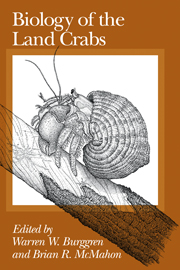Book contents
- Frontmatter
- Contents
- List of contributors
- Preface
- 1 BIOLOGY OF THE LAND CRABS: AN INTRODUCTION
- 2 EVOLUTION, SYSTEMATICS, AND GEOGRAPHICAL DISTRIBUTION
- 3 ECOLOGY
- 4 BEHAVIOR
- 5 REPRODUCTION AND DEVELOPMENT
- 6 GROWTH AND MOLTING
- 7 ION AND WATER BALANCE
- 8 RESPIRATION
- 9 CIRCULATION
- 10 ENERGETICS AND LOCOMOTION
- 11 EPILOGUE
- APPENDIX: Natural histories of selected terrestrial crabs
- References
- Author index
- Systematic index
- Subject index
10 - ENERGETICS AND LOCOMOTION
Published online by Cambridge University Press: 04 August 2010
- Frontmatter
- Contents
- List of contributors
- Preface
- 1 BIOLOGY OF THE LAND CRABS: AN INTRODUCTION
- 2 EVOLUTION, SYSTEMATICS, AND GEOGRAPHICAL DISTRIBUTION
- 3 ECOLOGY
- 4 BEHAVIOR
- 5 REPRODUCTION AND DEVELOPMENT
- 6 GROWTH AND MOLTING
- 7 ION AND WATER BALANCE
- 8 RESPIRATION
- 9 CIRCULATION
- 10 ENERGETICS AND LOCOMOTION
- 11 EPILOGUE
- APPENDIX: Natural histories of selected terrestrial crabs
- References
- Author index
- Systematic index
- Subject index
Summary
Introduction
The purpose of this chapter is to describe the general way that land crabs consume and use energy. Although techniques are available to measure food intake and its caloric content, and to determine the aerobic and anaerobic metabolism of organisms during activity and rest, a complete energetic evaluation of any animal, much less one for land crabs, has yet to be made. Thus, we are in possession of a few fragments of data – enough to embolden us to speculate but not enough to restrict our imagination.
This chapter presents an overview of the feeding process, digestion, assimilation, metabolism and the energetic cost of a variety of behaviors that crabs perform. Considerable information is available on locomotion, which is easily quantified and permits us to determine the metabolic range for each species. Other behavior patterns have scarcely been considered from an energetic point of view. This paucity of data will become evident in the following pages where we highlight the information that is required before we can work out an energy budget for any species.
Feeding
Crustaceans eat an enormous variety of food. Nutrition and feeding are reviewed by Marshall and Orr (1960) and Grahame (1983). Semi-terrestrial and terrestrial crustaceans include filter-feeders, scavengers, vegetarians, and predators (also see Chapter 3). Few studies have identified the specific food items taken by a given species, and no caloric studies have been made.
Filter-feeding
A large number of crabs living in the intertidal flats consume detritus. For instance, the fiddler crab Uca signatus lives in burrows and feeds nearby as the tide recedes. The crab picks up mud with its spoon-shaped chelae and rapidly shovels it into its mouth.
- Type
- Chapter
- Information
- Biology of the Land Crabs , pp. 333 - 377Publisher: Cambridge University PressPrint publication year: 1988
- 17
- Cited by

